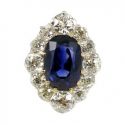In the 1920s and 1930s, two new types of rings came onto the scene: the cocktail ring and the dinner ring. Many people confuse the two, assuming that they’re the same, but in reality, they have distinct styles, and came about in distinct periods of time.
Cocktail Rings
Cocktail rings are flashy; they have a large stone in the center, with pave diamonds surrounding it, and they are worn on any finger except the left ring finger. They go back to the time of Prohibition when Americans started turning to illegal cocktail parties to get their alcohol. Combined with the new freedoms for women (in government and fashion), these parties became a way for women to flaunt their new independence. Because of the cocktail ring’s flashiness, women would often wear them as a symbol of their rebelliousness and independence.
Dinner Rings
Dinner rings came about during the 1910s and coexisted with cocktail rings during the 1920s and early 1930s. However, after Prohibition ended, dinner parties soon took over cocktail parties in popularity, as did the dinner ring. Less flashy and more mainstream, they were nevertheless still glamorous. While a “dinner ring” could refer to any number of non-engagement rings of this time, the most common style was the “north to south” style where the ring stretched along the length of the finger, rather than around it. Richly-colored stones (such as emeralds or aquamarines) were also used, surrounded by a halo of diamonds. Dinner rings would eventually fall out of style by the late 1930s, but would resurface during the late 1940s and 1950s, extending well into the new millennium.
Cocktail and dinner rings were popular in the 1920s and 1930s, but that doesn’t mean they have gone out of style. Whether you want the flashiness of a cocktail ring or the mainstream look of a dinner ring, Frank Pollak & Sons has a great selection of vintage rings for you to choose from.

